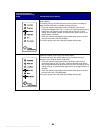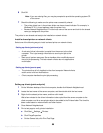
Argecy Computer Corporation 248-324-1800
90
3 Establish an FTP session with the print server. Expect the print server to return its current
firmware level (such as 2.5.15).
ftp
157.184.8.231
4 Using the FTP “put” command, print a file. This file can be PCL or PostScript emulations, PDF,
HTML, or any other printer language the printer understands. If the file prints, this confirms the
TCP/IP protocol is working properly in the print server.
put mytest.ps or
put mytest.txt
5 Check the port settings on the printer object. For example, in Windows 95 do the following:
a Click Start, Settings, Printers, select the printer object; click File, Properties, Details tab,
Port Settings button.
b Check all parameters on the Print Server Settings tab and the TCP/IP Settings tab. You
can change some of the values from this tab. Others, like TCP/IP address, you cannot
change from this tab.
c If a parameter is wrong but you cannot change it from here, you must delete the port, fix
the problem, and then add the port back.
6 Check all the settings in the print server. Type the MarkNet IP address in the URL address
field of your browser (for example, http://157.184.8.231), which takes you to the MarkNet
resident web page.
7 If you have trouble printing from an application, the problem might be the way your workstation
or application is set up.
a Try printing from some other application. If the job prints from the second application, the
problem is with the first application.
b Make sure you are using the current version of the driver for the problem application.
8 Try printing again.
Step 2: Set up to print
There are many ways to send a network print job including FTP, TFTP, LPR/LPD, point-and-print (IP)
and various queue-based methods.
Print to a queue on a Windows NT server
To use this method, you must have at least one server running Windows NT Server software and TCP/
IP.
Use direct IP printing if all you want to do is print directly to a network printer. If you need to centrally
manage your network printers, see instructions for
shared printing.
If all you want is basic printer functionality, you can use a system printer driver and a system IP port,
such as an LPR or a Standard TCP/IP port. Using a system printer driver and a system port lets you
maintain a consistent user interface for use with all the printers on your network.
To get the fullest range of printer functionality, including a job status window and printer alerts, you
need to install a custom driver and create a Network Port.


















